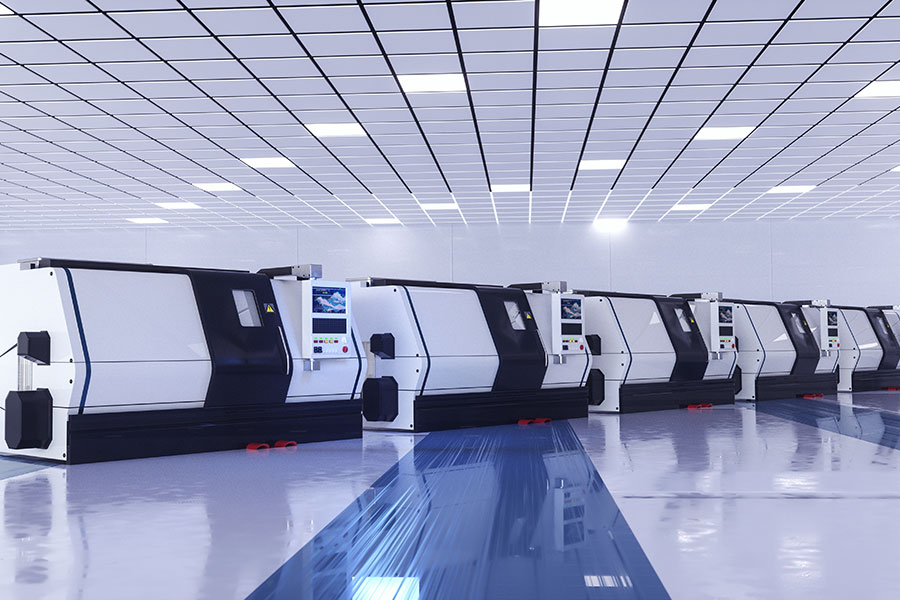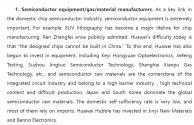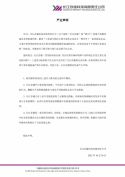Any idea how much Hubble had invested in the said technology? From what little I had gathered, it doesn't seem like they had spend nearly enough to come up with a 193nm Arfi system of their own.I wouldn't be surprised by Huawei... as Hubble's investments are directly aimed at DUV 193nm arfi lithography
You are using an out of date browser. It may not display this or other websites correctly.
You should upgrade or use an alternative browser.
You should upgrade or use an alternative browser.
Chinese semiconductor industry
- Thread starter Hendrik_2000
- Start date
- Status
- Not open for further replies.
With regards to ASML: the newly implemented Foreign Direct Product Rule, it states that anything which is made with anything controlled by the Export Administration Regulations (EAR) is presumed to be subject to US export controls - this catches the production of nearly every IC produced with AMAT/Lam/KLA product - however, ASML ArFi scanners are *not* subject to this requirement because for now, anything with <25% (to China and most other countries) de minimis by value US-origin products incorporated in their final product is not subject to the EAR. However, this is fairly easy to change since the Export Control Reform Act unambigiously gives the executive branch the power to set these extraterritorial standards so this state of being is highly uncertain.
The EU's current common set of export controls is a copy+paste of Wassenaar multilateral controls which for wafer lithography cover only EUVL - there is no legal basis for the Netherlands to be able deny an export of an ArFi scanner to China (but there was a legal basis to deny - or perpetually sit on the EUVL license application for China).
Btw, I'm going to be moderating this thread really closely from now on, so posts like this that are lazy and directly trying to agitate other members are going to get closer eye. This topic of what FDPR does and ASML's ability to get around it has been discussed at length by @paiemon and they are well worth the time for everyone to read. ASML itself has said that they will not problem continuing to sell to China for 2023.
I suggest you have some respect for people on this forum and read over items already covered on this topic.
That's fine. A while back, SMIC had a fab in Italy. Seeing that Chinese companies are increasingly looking to get higher share of high end manufacturing, they will probably need to set up more factories in Europe to keep local gov't happen. I don't think it needs to be with EUVs or anything like that. I think auto chips like MCUs and IGBTs would be needed to be made in Europe by Chinese IDMs like BYD and CRRC. Any higher end fab will probably come later when they have things figured out in China.That idea was before Ukraine.
Now I am more dubious regarding actual business autonomy of Europe. Our political representatives in Bruxelles put strategic dependency to US above interests of European people. People is not happy about it, but TV and media even don't show street protests that are taking place across Europe, and all official news and talk show guests are pure pro-war propaganda. Europe really changed a lot since last year.
In a more independent business environment, surely a Chinese fab in Europe, or even better in Holland, in JV with NXP (that is Dutch) or also with STM/Infineon would be something to consider. General purpose CPU, GPU or smartphone chips are of no interest in Europe, but automotive chips are, and because it has to be an advanced EUV fab to make sense, then autonomous-driving AI chips come to my mind as a possible target final product.
The collaboration could be even more vertical. For instance there could be a parallel JV or agreement between Biren or other Chinese AI chips developer with European advanced firms, universities and research centers (that have strong connections with Bruxelles).
So it would be a small but advanced EUV fab, fully de-Americanized, to manufacture Biren and siblings AI chips, all with participation of European semiconductor groups and research centers. That would be a clear win-win strategy: China would have guaranteed access to an advanced EUV fab that offers foundry services to Chinese AI companies, and Europe would have an European alternative to US in the future key AI chips market. And both China and Europe would have access to the European market that today is dominated by US.
Because of the last reason alone, the pressure of US to derail a possible China-Europe JV in AI chips would be huge.
I'm still amazed that they only think they will lose 5 to 10% of the sale. Who is going to buy from LAM when there is no support around.Still remember the Anti-Sanction Law? LAM will lose it all.
The Institute of Microelectronics of the Chinese Academy of Sciences has made progress in the field of artificial intelligence based on low power consumption
According to micronet news, recently, the low-power intelligent technology and microsystem team of the Perception Center of the Institute of Microelectronics, Chinese Academy of Sciences has made new progress in the field of low-power artificial intelligence.
It is reported that the voice wake-up technology is an important technology in the field of artificial intelligence, and the voice wake-up model of the high-performance deep convolutional neural network model usually has high complexity, large amount of calculation, and requires a lot of memory.
In this regard, the scientific research team of the Perception Center proposed an extremely lightweight and high-accuracy improved binary residual neural network B-ResNet for speech wake-up. Using the binary quantization method, the full-precision weights and activations in the neural network are used. The parameter quantization is 1bit (+1, -1), which significantly reduces the memory usage. It can also simplify the large number of floating-point convolution multiplication and addition operations in the network into XNOR XNOR logic and popcount operation, which greatly reduces the computational complexity.
In order to solve the problem of accuracy degradation caused by the binary network, the team proposed a shift initialization and learnable activation function in the forward propagation of the B-ResNet network to optimize the activation value distribution of each layer of the network, reduce the information loss, and reduce the loss of information. In the process of backpropagation, a gradient correction approximation method with variable periodic window is proposed, which can effectively solve the problem of gradient mismatch and disappearance. Under the 12-classification task of the GSCD standard voice data set, compared with the baseline network Res8-narrow, this technology can reduce the amount of parameters by 33% and the amount of calculation by 72%, and achieve higher voice wake-up accuracy, which is the low power consumption of the subsequent function. Hardware implementation lays a good foundation.
The demand for semiconductor equipment continues to grow, and the net profit of Tuojing Technology in the first three quarters is expected to increase by 296.80% to 314.05%
According to the disclosure, according to the preliminary calculation of the financial department, Tuojing Technology expects to achieve operating income of 950 million yuan to 1 billion yuan in the first three quarters of 2022, a year-on-year increase of 154.08% to 167.45%; it is expected to be attributable to the owner of the parent company in the first three quarters of 2022. The net profit of the company was RMB 230 million to RMB 240 million, a year-on-year increase of 296.80% to 314.05%; the net profit attributable to owners of the parent company after deducting non-recurring gains and losses in the first three quarters of 2022 is expected to be RMB 110 million to RMB 115 million. Compared with the same period of the previous year, it turned losses into profits, an increase of RMB 133,052,100 to RMB 138,052,100.
Tuojing Technology said that the company expects that the performance of the first three quarters of 2022 will increase compared with the same period of the previous year, mainly due to the continuous increase in equipment demand in the domestic semiconductor industry, the continuous growth of sales orders, and the company's operating income has achieved a significant year-on-year increase. At the same time, the gross profit level of the company's products has increased compared with the same period of the previous year, and the expense ratio during the period has decreased. improve.
According to the data, Tuojing Technology is mainly engaged in the research and development, production, sales and technical services of high-end semiconductor special equipment. The company's main products include plasma-enhanced chemical vapor deposition (PECVD) equipment, atomic layer deposition (ALD) equipment and sub-atmospheric pressure chemical vapor deposition (SACVD) equipment, three product series, which have been widely used in domestic fabs for 14nm and above processes The integrated circuit manufacturing line breaks the monopoly of international manufacturers on the domestic market in the field of high-end semiconductor thin film deposition equipment, and directly competes with international oligarchs. The company is currently the only domestic manufacturer of integrated circuit PECVD equipment and SACVD equipment for industrial application, and also a leading domestic integrated circuit ALD equipment manufacturer
That's fine. A while back, SMIC had a fab in Italy.
If you refer to this one
It is a very old fab, ex-TI, ex-micron, ex-management buyout, etc, etc..
Now the owners are still Chinese, but they don't know what to do with it. They produce low-end 110-150nm CIS image sensors for their single customer On Semiconductor. They have a contract with Onsemi until 2024, after that...who knows!
This is not the example of a possible shiny China JV in Europe. It should be a new fab, or anyhow the expansion and development of an exsisting one. Regarding the Italian fab, it is more than 20 years that nobody puts an euro on it....
Shengjian Environment: Subsidiary won an order of 100 million yuan for semiconductor process auxiliary equipment from NAURA

On October 20, Shengjian Environment announced the signing of a major order. Shanghai Shengjian Semiconductor, a wholly-owned subsidiary of the company, and NAURA Microelectronics, a wholly-owned subsidiary of NAURA, signed a Local Scrubber (abbreviated as NAURA Microelectronics) for semiconductor process equipment. "L/S") purchase order with a total contract value of 100 million yuan.
According to reports, the equipment is used for the source treatment of toxic and harmful waste gas with complex composition represented by elements such as fluorine, chlorine, silicon and other elements generated during the process. One end of the equipment is connected to the process equipment of the pan-semiconductor factory, and the exhaust gas generated in the process equipment is extracted and decomposed by a vacuum pump; the other end is connected to the central treatment system, and the decomposed exhaust gas is discharged to the central processing device for subsequent treatment. Local Scrubber is a part of semiconductor process equipment. It has high requirements on operation stability and gas processing efficiency, and can effectively guarantee the capacity utilization rate, product yield, employee occupational health and ecological environment of pan-semiconductor customers. It is the production process of pan-semiconductor customers. inseparable part.
Shengjian Environment said that the performance of the company's Local Scrubber and other process auxiliary equipment has reached the level of foreign counterparts, and has better cost performance, especially in terms of delivery capacity, installation, commissioning and after-sales service response speed, and localized manufacturing supply chain support. It has obvious advantages, and the penetration rate still has a lot of room for improvement.
The Bloomberg article possibly confuses quarters and years. It would make sense to sell $18 billion in 2022 and then decline to $2 to $2.5 billion in 2023.Lam Research expects 2023 revenue in China to fall by $2 billion to $2.5 billion
View attachment 99859
It’s actually not that different in principle to radar signal processing or any other kind of photon scatter based pattern recognition technique. Similar techniques are used in a lot of biotech and chemical detection and analysis equipment. If you get a specific scatter pattern you can reproduce the physical properties that generate the scatter pattern for a given set of properties with your light source. This isn’t to say that this stuff is easy but the principles are rather straightforward.Holy crap, this is amazing. I've always thought that nanoscale optical metrology was something out of reach for Chinese companies. To me optical CD is kind of like black magic because it isn't something you can directly understand, there's a ton of assumptions and theory behind it.
- Status
- Not open for further replies.


